Nutrition in Plants Worksheet
Objective Type Questions
- Rearrange the letters to form meaningful words based on the clues provided.
a. Insect eating plants – SIVNECORIEST
b. Organisms which take in nutrients from dead and decaying matter –ATROPRSOPHS
c. Association of fungi and algae – HLINCE
d. Bacterium which lives in roots of legumes – UORZBIMHI - Match the terms in column A with appropriate terms in column B.

Multiple Choice Questions - Which of the following statements best defines the term ‘nutrition’?
a. It is the amount of food present in the body.
b. It is the components of food required by the body.
c. It is the mode of eliminating food by the individual.
d. It is the mode of obtaining food by the individual.
- A teacher asked the students to list the points about the importance of nutrition in living organisms. The table shows the list prepared by the students.

Which points listed by the students are correct?
a. I and II
b. I and III
c. II and III
d. II and IV
- The table shows the mode of nutrition in two different organisms.

What is the likely to be the mode of nutrition of the two organisms?
a. Organism 1 = Autotrophic, Organism 2 = Autotrophic
b. Organism 1 = Autotrophic, Organism 2 = Heterotrophic
c. Organism 1 = Heterotrophic, Organism 2 = Autotrophic
d. Organism 1 = Heterotrophic, Organism 2 = Heterotrophic - The image shows a part of the food chain.
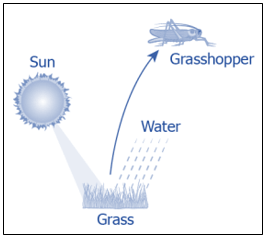
A student claimed that grasshopper has a heterotrophic mode of nutrition. Is the claim made by the student, correct?
a. No, as the grasshopper prepares its own food.
b. No, as the grasshopper provides food to the plants.
c. Yes, as the grasshopper takes in food prepared by the grass.
d. Yes, as the grasshopper takes in food prepared by other grasshoppers. - Jayesh takes a green leaf from the plant and boils it in an alcohol bath for the removal of chlorophyll. After this treatment, he adds a few drops of iodine to the boiled leaf using a syringe dropper. After some time, he observes that the leaf turns blue-black in colour. What can be evaluated from this?
a. The iodine reacts with the starch present in the leaf that indicates the occurrence of photosynthesis.
b. The iodine reacts with the water present in the leaf that indicates the occurrence of photosynthesis.
c. The iodine reacts with the oxygen present in the leaf that indicates the occurrence of photosynthesis.
d. The iodine reacts with the carbon dioxide present in the leaf that indicates the occurrence of photosynthesis. - Rashmi set up an experiment using two potted plants in the same type of soil. She kept one plant in the garden and the other in a dark room and watered both the plants equally. After five days, she observed that the plant in the dark room died while the plant in the garden appeared healthy. What is the likely reason for this observation?
a. Lack of water for the growth
b. Lack of minerals for the growth
c. Lack of sunlight for photosynthesis
d. Lack of carbon dioxide for respiration
- Cuscuta is a yellow, wiry, branched structure that climbs on other plants as it lacks chlorophyll. A student sets up an experiment using two potted plants, one with Cuscuta and the other without it as shown below.

Which of these plants will show more growth?
a. Plant A, as Cuscuta provides valuable nutrients to the host plant for photosynthesis.
b. Plant B, as Cuscuta shares chlorophyll of the host plant to synthesis its own food.
c. Plant B, as Cuscuta uses readymade food of plant A that weakens the host plant.
d. Plant A, as Cuscuta shares its readymade food with the host plant to increase their combined growth.
- The chart lists the characteristic of a plant.

Based on the above characteristics, what is likely to be the mode of nutrition of this plant?
a. Autotrophic
b. Heterotrophic
c. Autotrophic and Heterotrophic
d. Autotrophic and Parasitic - The given image shows two different organisms.
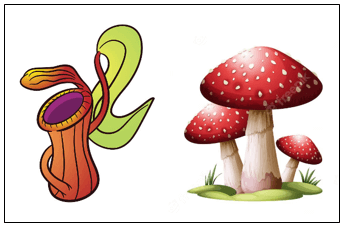
Which of these characters is shared by both?
a. Both require plenty of sunlight.
b. Both depend on food prepared by other organisms.
c. Both have a saprotrophic mode of nutrition.
d. Both have chlorophyll to perform photosynthesis. - Listed below are some characteristics of organisms X, Y and Z. Which option correctly classifies these characteristics?

- The model shows how a farmer plants the crop in different beds in three consecutive years. What is the likely benefit of this pattern of planting crops?
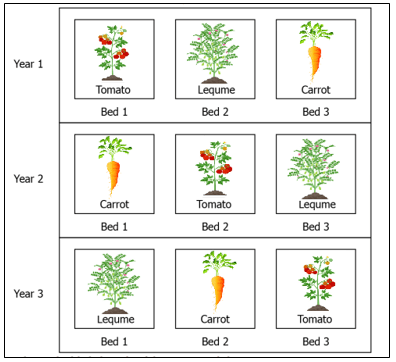
a. It increases the height of the crops.
b. It increases the fertility of the soil.
c. It reduces the water requirement of crops.
d. It increases the same type of nutrients in the soil. - A farmer observes the growth of Rhizobium on the roots of pea plant as shown below. How is this likely to benefit the farmer?
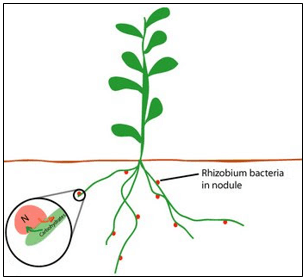
a. It will increase the growth of unwanted plants.
b. It will increase the use of manures in the field.
c. It will reduce the need of nitrogenous fertilisers in the field.
d. It will reduce the need for raw material by the plants to prepare their own food.
Subjective Questions - The given picture shows the section of a leaf. What is the likely role of the labelled part in the leaf?
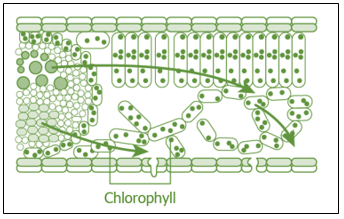
- The given image shows the structure of stoma on the leaf. What will be the likely effect on the plant, if stoma remains closed for a prolonged period of time?
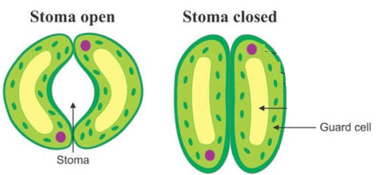
- Sneha collected different coloured leaves from her garden. Which of these leaves performs photosynthesis? Give reason for your answer.

- How do plants fulfil their nitrogen requirements?
Case-Based Questions - The given picture shows how plants prepare their food.
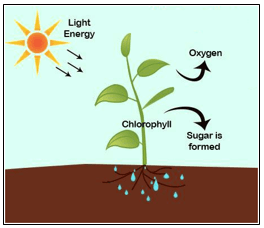
a) Based on the given picture, what can you say about the mode of nutrition in plants?
i. Autotrophic, as plants obtain food in the form of sunlight.
ii. Heterotrophic, as plants consume food prepared by other organisms.
iii. Autotrophic, as the plants prepare their own food using water, carbon dioxide, sunlight, and chlorophyll.
iv. Heterotrophic, as plants obtain prepared food in the form of water and carbon dioxide.
b) Which raw materials present in their surroundings are used by plants to prepare their food?
i. Water, minerals, and proteins
ii. Fats, minerals, and proteins
iii. Water, carbon dioxide and minerals
iv. Proteins, fats, and carbohydrates - Photosynthesis is important for the existence of life on the Earth. The survival of almost all living organisms directly or indirectly depends upon the food made by the plants. In the absence of photosynthesis, life would be impossible on the Earth.
a)Define ‘Photosynthesis’.
b)Which equation correctly describes the process of photosynthesis?
Assertion-Reasoning Questions
Below questions consist of two statements – Assertion (A) and Reason (R). Answer these questions selecting the appropriate option given below:
- Assertion (A): In cactus plant, the stem and branches carry out photosynthesis.
Reason (R): They are green in colour due to chlorophyll. - Assertion (A): Sun is the ultimate source of energy for all living organisms.
Reason (R): Plants prepare food in the presence of sunlight; hence the process is called photosynthesis.
Explore more Science Sample papers and Solutions
-
Sample Papers for CBSE Class 7 Science Term 1 #1
-
Sample Papers for CBSE Class 7 Science Term 2 #1
- Nutrition in Animals Worksheets
- Heat Worksheet
- Acids, Bases And Salts Worksheet
- Physical And Chemical Changes Worksheet
- Respiration in Organisms Worksheet
- Transportation In Animals And Plants Worksheet
- Reproduction in Plants Worksheet
- Motion And Time Worksheet
- Electric Current And Its Effects Worksheet
- Light Worksheet
- Forests: Our Lifeline Worksheet
- Wastewater Story Worksheet
- Competency Based Questions for CBSE Class 7 Science
- Sample Papers for CBSE Class 7 Science Term 1 #2
- Sample Papers for CBSE Class 7 Science Term 2 #2
Key Features of Study Materials of CBSE Class 7 Science:
- Easiest and most comprehensive study materials
- Designed by subject matter experts
- Revised according to the latest CBSE syllabus
- Helpful for quick revision
- ‘Ask a Doubt’ facility
- Significant improvement in marks



